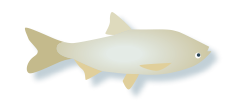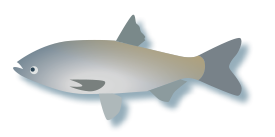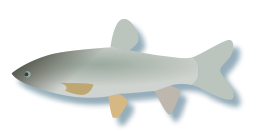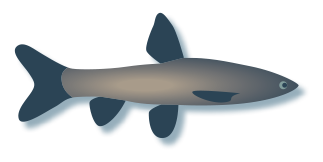Asian Carp Response Plan
Fisheries and Oceans Canada (DFO), in partnership with the Ontario Ministry of Natural Resources and Forestry (MNRF), has developed an Asian Carp Response Plan under the Incident Command System (ICS) framework. This plan describes how DFO, MNRF, and their partners will respond if Asian carps are detected in the Great Lakes. As with any natural disaster or environmental emergency, a co-ordinated response effort is required when multiple responsible agencies are involved. These response efforts use the ICS framework to create a unified command structure (see figure below) across partner agencies that is scalable to the size and severity of the incident. Immediately following the verified capture of an Asian carp, an ICS structure is stood up and the response plan is implemented.
The response plan describes different incident levels and their triggers (i.e. which species, how many, fertility) and the appropriate actions to be taken in each case. It outlines the command structure, including roles and responsibilities of those involved. Emphasis is placed on safety, and on proper communication flow within the structure, between responding agencies, and with the public.
The Asian Carp Response Plan is intended to be a living document that evolves as the understanding of Asian carp biology, ecology, control and management improves. DFO and partners will continue training for response activities, both in-class and on the water, to refine our practices and integration, in preparation for real events.
Incident Command System
Incident Commander Liaison Officer Communications Officer (PIO) Operations Chief Logistics Chief Planning Chief Strike Team Lab Analysis Service Advisory Team Strike Team Strike Team Strike Team



Incident Commander
The Incident Commander manages the entire response and assigns individuals to the key roles within the command structure.Liaison Officer
As there are two agencies involved in managing responses in Ontario (OMNRF and DFO) one of the key roles in ICS is liaising between the agencies to ensure coordination of resources, assets and expertise. The Liaison Officer works closely with the Incident Commander to advise and deliver in this important role.Communications Officer
The Communications Officer primarily role is to inform the public about an incident and a response. The Communications Officer manages media inquiries, public messaging, internal messaging and issues management related to the incident.Operations Chief
The Operations Chief manages the on-water response to an incident, deploys crews, assesses water bodies & manages all resources including human and financial related to the incident.Logistics Chief
The Logistics Chief manages real property assets for use during the incident. This role helps to ensure that all members of the ICS structure have the tools and resources needed to complete their tasks.Planning Chief
In an Asian Carp incident, this role is crucial to the level of response undertaken. Primarily the Planning Chief will conduct lab analysis on animals that have been captured to confirm species and fertility status. Based on the results, the Incident Commander then decides whether a response should be increased, maintained or scaled back.Asian Carp Response Plan
Fisheries and Oceans Canada (DFO), in partnership with the Ontario Ministry of Natural Resources and Forestry (MNRF), has developed an Asian Carp Response Plan under the Incident Command System (ICS) framework. This plan describes how DFO, MNRF, and their partners will respond if Asian carps are detected in the Great Lakes. As with any natural disaster or environmental emergency, a co-ordinated response effort is required when multiple responsible agencies are involved. These response efforts use the ICS framework to create a unified command structure (see figure below) across partner agencies that is scalable to the size and severity of the incident. Immediately following the verified capture of an Asian carp, an ICS structure is stood up and the response plan is implemented.
The response plan describes different incident levels and their triggers (i.e. which species, how many, fertility) and the appropriate actions to be taken in each case. It outlines the command structure, including roles and responsibilities of those involved. Emphasis is placed on safety, and on proper communication flow within the structure, between responding agencies, and with the public.
The Asian Carp Response Plan is intended to be a living document that evolves as the understanding of Asian carp biology, ecology, control and management improves. DFO and partners will continue training for response activities, both in-class and on the water, to refine our practices and integration, in preparation for real events.
